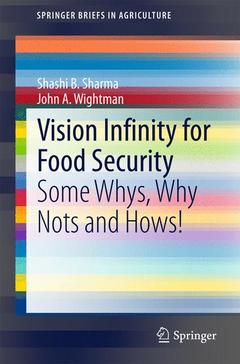Description
Vision Infinity for Food Security, 1st ed. 2015
Some Whys, Why Nots and Hows!
SpringerBriefs in Agriculture Series
Authors: Sharma Shashi B., Wightman John A.
Language: English
Keywords
Agriculture; Biosecurity; Food value chains; Globalisation; Trade
52.74 €
In Print (Delivery period: 15 days).
Add to cartSupport: Print on demand
Description
/li>Contents
/li>Biography
/li>Comment
/li>
A new perspective on the global food security situation and highlights the need for seeking a common vision and implementing global planning to define the manner in which the human species will manage its food security. The basic question of ?is there enough food? is examined in general and then in some detail. The history of food production is reviewed in the hope that lessons can be learned from the past. But even after ten thousand years of experience we are not able to feed adequately about a third of our total population, despite what statistics can be made to tell us. Intensive agriculture has stripped out the nutrients that support plant growth and marginalised extensive tracts of land. The global solution to feed the growing population has been and continues to be ? produce more food. Even during the last 30 years, about 95 percent of global research investments have focused mainly on increasing productivity. However about a third of the food produced, sufficient to feed over two billion hungry people, is lost or wasted in the food value chain. Climate change is another confounding factor that impinges on our discussions. Pests of all kinds continue to destroy food before and after it is harvested, even though the technology to protect it is available. A huge amount of food is wasted in value chains, particularly at the domestic level. Global food production systems are exposed to unprecedented biosecurity risks posed by invasive harmful organisms and this trend is likely to further exacerbate as current approach to biosecurity is based on the notional premise that lines on maps and the legislation that goes with them is sufficient to halt epidemics. Solutions include extending the number of cultivated plant and animal species to include those that can prosper in what are currently considered to be extreme environments.
Preface
List of tables, figures and boxes
Acknowledgment
1: Introduction
2: Is there enough food?
3: Food security – how did we get to where we are now?
4: Are there fundamental constraints to food security?
5: Biosecure global food value chains
6: Exploit additional food sources
7: Eliminate food losses
8: Rethinking agro-ecosystems and diversity with farming systems
9: In search of answers – tying it all together
10: Way forward
Applies novel approach and vision to examine the global food security issue
Highlights the need for considering biosecurity as an integral part of global food security strategy
Recommends adoption of a ‘3Ps Mantra’ to transform the current global emphasis on ‘producing more food’ to ‘whole of food value chain’ for achieving sustainable global food security for the present and future generations
Explores new answers for enhancing availability of nutritious food for the present and future generations
Includes supplementary material: sn.pub/extras




